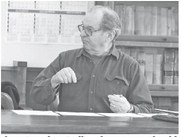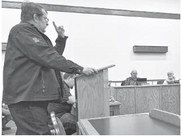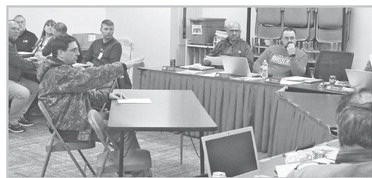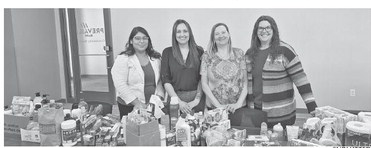Sewer loan program heads to board
County board to consider program to help residents replace septic systems
Rural homeowners in Taylor County may soon have more options on how to pay for septic system repairs.
At a special joint meeting of the finance, ad hoc and zoning committees on Nov. 14, committee members voted to send a proposed county-run loan private onsite waste treatment system (POWTS) program to the full county board for final approval.
The meeting has been the culmination of more than a year of work by the county zoning department and an ad hoc committee set up to look into the idea and develop a workable solution.
State codes require the county to keep track of POWTS under a permitting system. According to zoning administrator Kyle Noonan, there are currently about 4,600 active permits in the county and an estimated 2,000 unpermitted systems. Under the codes, systems must be maintained and failing systems repaired or replaced. Failing systems can lead to contamination of ground and surface water creating the potential for human health and environmental hazards.
The challenge, Noonan explained, is that while there are state programs that assist low-income homeowners, there are few options for those whose incomes or asset levels do not allow them to qualify for those programs.
“What we are seeing are households that make a decent living, but struggle to find the extra money needed,” Noonan said. He said they are seeing POWTS cost in the $8,000 to $20,000 range depending on the size and type of system installed.
The county idea is to use county reserve funds to set up a revolving loan program. Under the program, homeowners would use the money to pay for the POWTS work and the county would issue a mortgage on the property until the loan amount was paid off. If the homeowner defaulted, the county would have the option to pursue foreclosure, as well as the ability to impose a special assessment on the parcel’s property taxes.
Interest costs would be through administrative fees that would cover both the interest and the cost of the county administering the program.
Committee member Lester Lewis who has been a proponent of the program, said the plan was to cap the amount to be loaned out at any time at $300,000. He estimated this would keep it to about 30 active loans. As with any revolving loan program, as funds are repaid they will be available to be lent out.
Over the past year, the ad hoc committee has created a procedure manual and has solicited for proposals from both Northwest Regional Planning Commission and the Taylor County Housing Authority (TCHA) to administer the program. The committee recommendation is to go with TCHA for administration.
County finance committee chairman Chuck Zenner questioned if the committee had looked at the option of the program being run through a bank or credit union with the county providing a loan guarantee. Lewis said the committee preferred to not go in that direction over concerns regarding the potential administration cost.
Committee member Gene Knoll also said he felt the chances were slim that with the small size of the program, they would have difficulty in finding a bank interested to run it.
With the legwork done on how the program would run and who would manage it, the big question facing the county is where the money would come from to initially fund the loans.
“The sticking point is where the funds would come from,” said committee member Scott Mildbrand.
Lewis proposed taking $200,000 from the county remediation fund. When tax deeded property is sold, a portion of the amount of the sale goes into a fund to cover needed environmental clean up. The fund currently has about $235,000 in it.
“There are several different ways to fund this,” Knoll said. He suggested the county could approach a bank or a group of banks to set up a line of credit for the county and the lower municipal rates. The county could then tap into the line of credit in order to make the loans to the homeowners and pass along the interest expense. Knoll guessed interest rates for the county could be under 3%.
“I am not in favor of the line of credit,” Lewis said, noting the fees being charged as part of the program would not cover the costs. It was noted they could be refigured to cover the costs.
Knoll said it was looking at if the county wanted to tied up their own reserve funds or if it wanted to borrow the funds. Knoll also noted that banks may be more willing to participate as a way to earn points in their Community Reinvestment Act (CRA) ratings. CRA is a law intended to encourage depository institutions to help meet the credit needs of the communities in which they operate including low to moderate income residents. Knoll said he thinks it would be a CRA qualified investment and would be beneficial for banks to participate.
“I don’t think it would be bad to look at,” Zenner said.
Lewis noted that waiting to get something set up with the banks would delay the program to get running. He said the county could start with the $200,000 that is on-hand. “The whole point was to keep the cost down,” he said.
Committee members were in consensus about the need to start somewhere and while there was interest in pursuing partnerships with financial institutions, using available reserves will allow the program to get going sooner.
Committee member Tim Hansen raised concern about the county assuming the position of “lender of last resort” and of the potential for risk. Noonan responded that the program would not meet the needs of all homeowners and that low income people would still be referred to programs through TCHA.
“We are not looking at lower income, we are trying to get the middle ground,” Lewis said, of the target for the program. He said the program is intended to help the gap population and give them a chance.
As far as risk, the county has three ways of collection, through regular payments, through foreclosure of the mortgage, and through special assessment against the parcel’s property taxes. “We have better protection than lender ABC down the road because we can assess it,” Knoll said.
While the majority of those in the joint committee favored the program, committee member Ray Soper voiced his objection saying that he felt the right solution is for people to work through private lenders. In the end, Soper recorded the only “no” vote as members of the joint committee voted 10-1 to send it to the full county board for final action.





